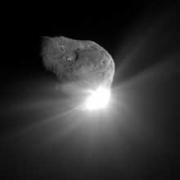Comets
Comets are thought to be among the most primitive bodies left over from the planetesimal building stage of the solar nebula, and so their physical and chemical composition provides an important link between nebular and interstellar processes. A fundamental goal of cometary investigations is to understand the origin and nature of cometary nuclei, in order to explore how they link back to the protoplanetary disk. Of particular interest are parent molecules, those which sublime directly from the nucleus, as measurement of their abundances can reveal relative abundances in the nucleus itself and therefore information about the conditions in which the comet formed. High angular and spectral resolution interferometry is essential to yield constraints on the photochemistry and chemical reactions which occur in the innermost coma since emission on large spatial scales can be selectively resolved out. RG astronomers use the Submillimeter Array to obtain images of thermal dust continuum emission and spectral line emission from the gas molecular species from the inner coma of comets to study the isotopic fractionations and chemical abundances difference between nuclear, extended sources and jets -- gas sublimating from active spots on the nucleus.
Mark Gurwell, Chunhua (Charlie) Qi




